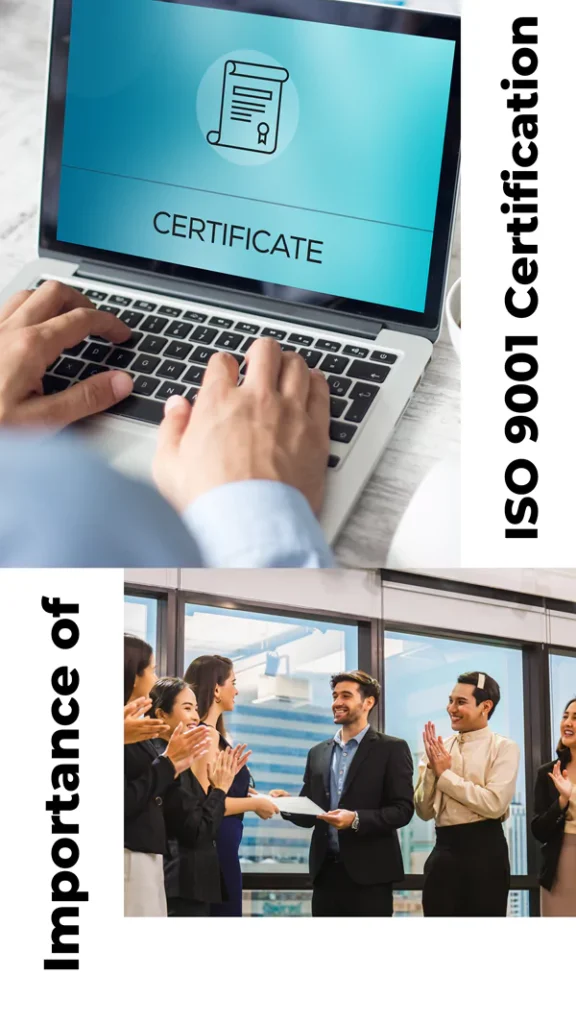ISO 9001 Certification
The International Organization for Standardization (ISO) created the Quality Management Systems (QMS) standard ISO 9001, which is widely regarded. It offers a framework that businesses may use to develop good quality management procedures, continuously satisfy client needs, and adhere to relevant legal requirements. Customer satisfaction, process improvement, risk-based thinking, and evidence-based decision-making are just a few of the topics covered by ISO 9001. Businesses may increase productivity, lower errors, and show their dedication to providing high-quality goods and services by adhering to ISO 9001.
APPLY NOW
Importance of Taking
ISO 9001 Certification
The following factors make the ISO 9001 certification very important to organizations

Increased Efficiency: ISO 9001 QMS contributes to process simplification by lowering waste, mistakes, and rework, which boosts productivity and lowers costs.
Competitive Advantage: Organizations with ISO 9001 certification Online stand out from rivals and are more appealing to clients and business partners.
Better Decision Making: ISO 9001 encourages decision-making based on facts and data in order to make wise decisions.
Continuous Improvement: ISO 9001 promotes a continuous improvement culture that encourages enterprises to proactively identify and address areas for improvement
Risk Management: The standard includes risk-based thinking, assisting companies in recognizing and controlling possible hazards while promoting resilience and adaptation.
Compliance with Regulations: ISO 9001 aids in adhering to regulations, lowering the risk of non-compliance and related fines.
Increased Stakeholder Confidence: QMS Certificate raises stakeholder confidence in the organization’s dedication to quality, including that of partners, suppliers, and investors.
Staff Engagement: ISO 9001 promotes staff participation in process improvement, which fosters a sense of ownership and pride in making a difference in the success of the company.
How much does ISO 9001 Certification Cost
The cost of obtaining ISO 9001 certification can differ significantly depending on a number of variables, including the size of the firm, the complexity of its operations, the certification’s scope, and the certification body selected. The following are some of the primary cost factors to think about:
Certification Body expenses: The certification body’s expenses for conducting audits and providing the Quality Management System Certificate are the main expense. These costs can fluctuate greatly across various certifying bodies.
Preparation Costs: on order to achieve the ISO 9001 requirements, organizations may need to engage on training services, and process enhancements, which can raise the overall cost.
Internal Resource: The staff members’ time and effort spent getting ready for the certification and taking part in the audit also go toward the overall cost.
Recertification Fees: Getting ISO 9001 certification is only valid for a specific amount of time (often three years), after which it must be renewed. Recertification fees should also be taken into account
Maintenance Costs: Ongoing expenses like internal audits and process enhancements may be incurred to maintain the Quality Management System in accordance with ISO 9001 requirements.
Documents Required
for Applying ISO 9001 Certification

Company / Service Govt. Registration Proof

Valid Letter Head including Address

Quality Manual

Internal Audit/MRM
Frequently Asked Questions
ISO 9001 Certification FAQ
The entire procedure, from the initial meeting with our ISO experts to certification, may take as little as 45 days. However, how big and complicated your firm is will affect this.
Remember that by producing the Documented Management System Manual for you, we can typically save you time and money. Additionally, it may hasten the accreditation process for your company.
Remember that by producing the Documented Management System Manual for you, we can typically save you time and money. Additionally, it may hasten the accreditation process for your company.
Please download our ISO 9001 checklist to discover what information you will need to supply to meet the ISO 9001 standards for additional information on what it takes to obtain an Online ISO 9001 Certification.
Any type of business entity, regardless of size—small, medium, or large—can seek for ISO certification.
The requirements of the certifying body, the organization's size, complexity, and past audit results are just a few of the variables that might affect how frequently ISO 9001 audits are performed. There are primarily two types of ISO 9001 audits:
Initially, the certification audit: This is the initial audit done to see if an organization's quality management system (QMS) complies with ISO 9001 standards. When an organization applies for ISO 9001 certification for the first time, the certification audit happens only once.
Follow-up audit for the surveillance audit: An organization is subject to ongoing surveillance audits after Getting ISO 9001 certification. These audits are performed on a regular basis (often every six months or once a year) to make sure the organization maintains compliance with ISO 9001 standards for the duration of the certification's validity.
Depending on the policies of the certifying authority and the risk assessment of the organization's QMS, the quantity and length of surveillance audits may change. The surveillance audits may be less frequent or last for a shorter period of time for firms who have a great track record of compliance.
Since these audits are necessary to Obtain ISO 9001 certification, it is crucial for enterprises to be ready and keep their QMS in compliance at all times. In the event of non-compliance during audits, corrective measures including, in extreme circumstances, suspension or removal of the ISO 9001 certification may be taken.
A framework for implementing efficient quality management techniques is provided by ISO 9001, a widely accepted standard for quality management systems (QMS). The goal of ISO 9001 is to support businesses in continuously improving their operations and general performance while also assisting them in consistently meeting client expectations. The following are the primary focuses for ISO 9001:
1.Customer Focus: Businesses must recognize and comprehend the demands, expectations, and requirements of their customers. Making sure that goods and services satisfy these needs of customers and increase their satisfaction is the aim.
2.Leadership: for ISO 9001 to be implemented successfully, top management is essential. Leaders must show a dedication to quality, establish a transparent quality policy, and specify quality goals for the organization.
3.Participation of People: All employees must possess the necessary skills, authority, and involvement in the quality management processes. Their participation is essential to the QMS's efficient operation.
4.Adopting a process-based approach: to operating the organization is stressed by ISO 9001. This entails locating, comprehending, and overseeing interconnected processes that support the goals of the company.
5.Improvement: One of the guiding principles of ISO 9001 is continuous improvement. Organizations need to periodically review and analyze their processes to find areas for improvement and put the right corrective and preventive measures in place.
6.Using evidence-based judgment: Organizational decisions should be supported by statistics and factual knowledge. Making informed judgments requires the use of performance indicators, metrics, and data analysis.
7.Relationship Administration: To improve overall performance, businesses are encouraged to establish and maintain productive connections with their suppliers and other key stakeholders.
8.Using a risk-based perspective: Organizations are required by ISO 9001 to recognize and deal with risks and opportunities that could affect their capacity to supply compliant goods and services, satisfy customer needs, and raise customer satisfaction.
9.Context of the Organization: When preparing and implementing quality management procedures, organizations must take into account both internal and external elements that could have an impact on the QMS.
10.By concentrating on these essential components: QMS ISO 9001 assists businesses in establishing a solid quality management system that promotes customer happiness, effectiveness, and continuous development, ultimately resulting in long-term market success.
The 10 clauses that make up ISO 9001 are based on the structure found in Annex SL.
Clause 0 to 3: Introduction, Scope, References, Terms and Definitions
Clause 4: The organization's context
Clause 5: Initiative and dedication
Clause 6: Developing the QMS ISO 9001
Clause 7: Management of resources and support
Clause 8: Control and planning for operations
Clause 9: Evaluation of performance
Clause 10: Actions for improvement
